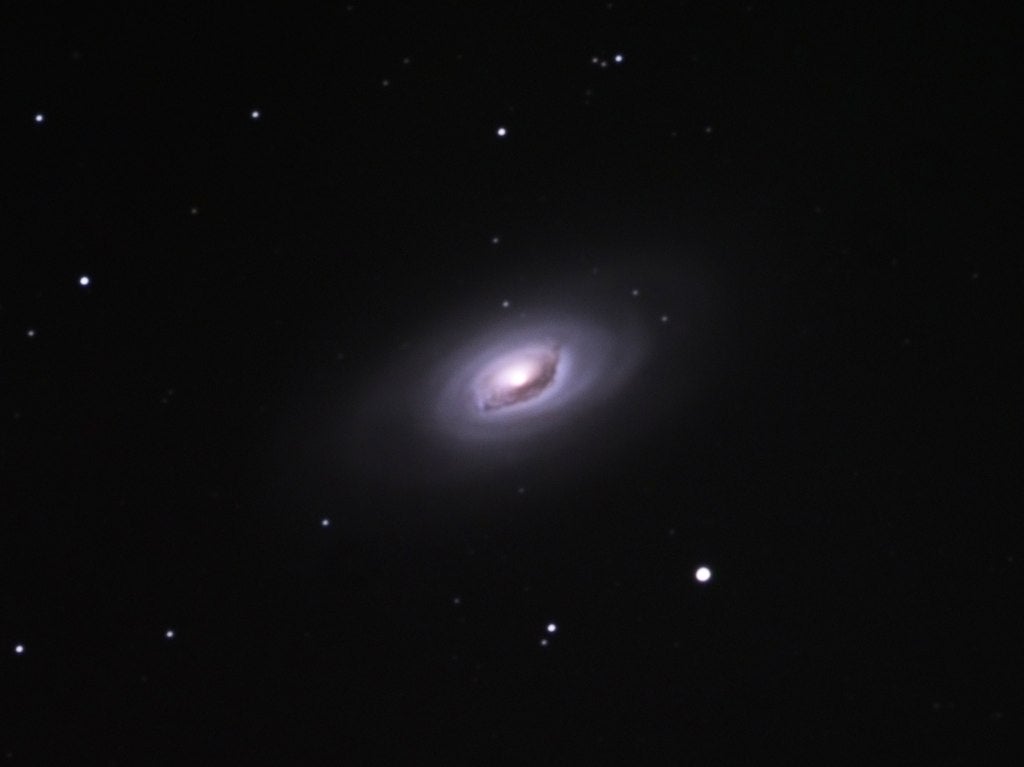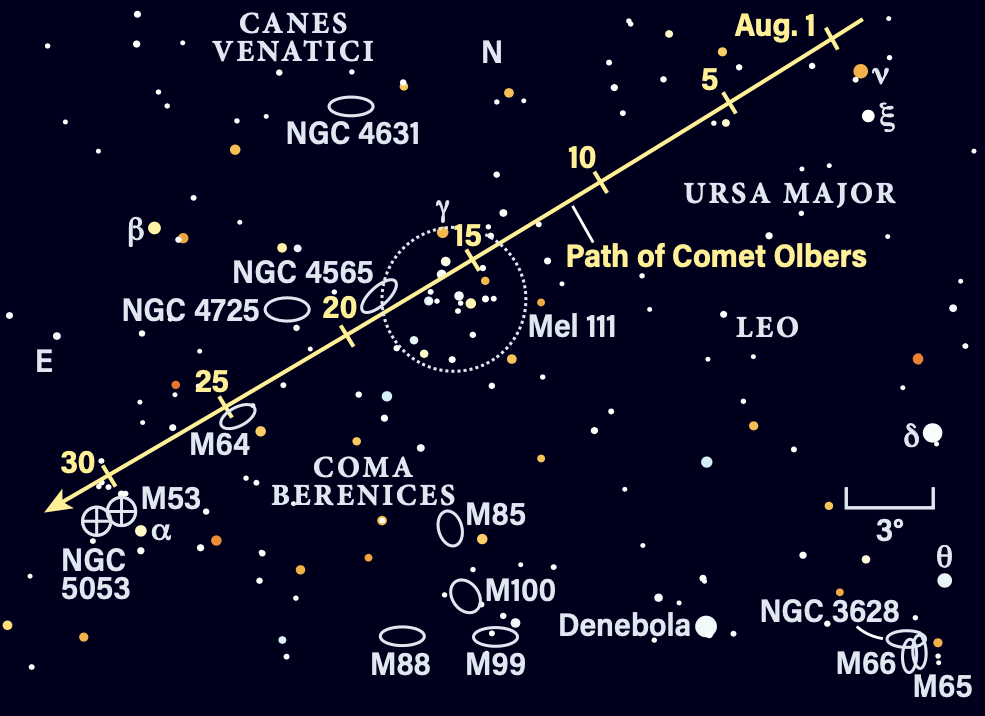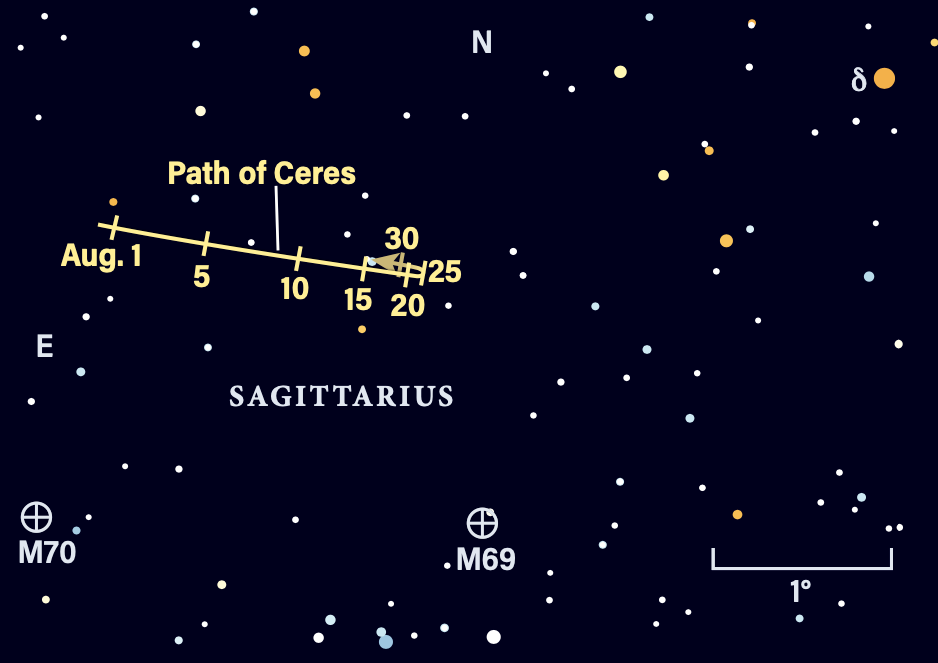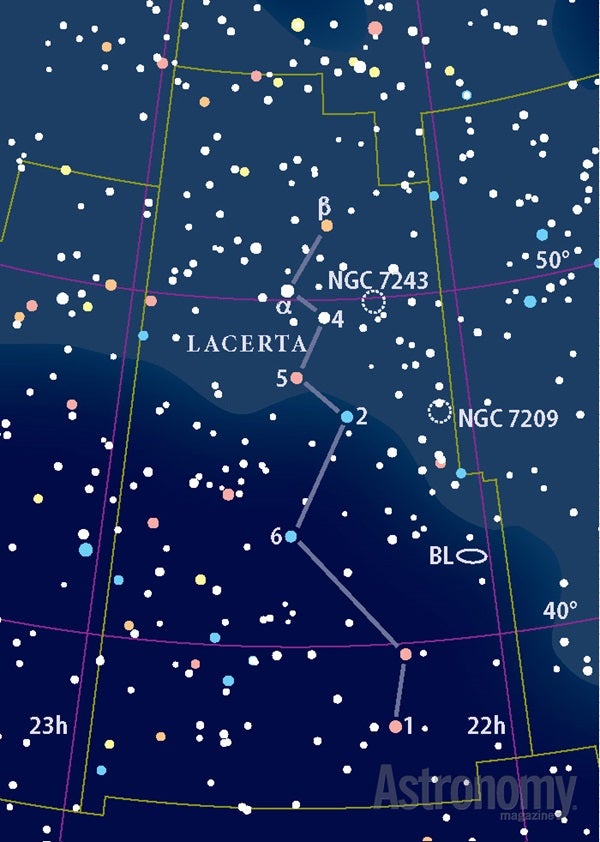
Friday, August 23
There’s a short dark window this evening to catch one of the most popular galaxies that amateur astronomers love to observe: M51, the Whirlpool Galaxy. Located in the small constellation Canes Venatici, which is slowly sinking toward the northwest horizon after dark, the Whirlpool is a gorgeous face-on spiral with a small, compact companion nearby.
Canes Venatici sits below the curve of Ursa Major’s tail, a region better known as the Big Dipper. Once you’ve found the Big Dipper, locate the star at the very end of the handle, 2nd-magnitude Alkaid (Nu [ν] Ursae Majoris). The Whirlpool lies just 3.5° southwest of this star, in sparse northeastern Canes Venatici.
Because it is face-on, M51 is fainter than it would be if it were tilted more sideways with respect to our line of sight. It glows at magnitude 8.4, with its fuzzy center more apparent than the faint, winding arms. Small scopes will certainly pick up that bright nucleus, but it may take some time — and a decent-sized scope (8 inches or so) — to spot the arms and make out detail. Make sure to set yourself up for success, with an observing site far from light pollution and by looking earlier in the evening as soon as it grows dark, rather than later, when the region is close to the horizon.
M51’s pronounced arms caused astronomer William Parsons, Earl of Rosse, to call it a “spiral nebula” in 1845. In the two centuries that followed, many similar spiral nebulae were found — which astronomers ultimately determined were not nebulae at all but entire galaxies, each like the Milky Way.
Look also for 10th-magnitude NGC 5195, M51’s small, compact companion, which lies some 4.5′ north of M51’s core. (M51 is also cataloged as NGC 5194.) The smaller galaxy has been caught in an ongoing interaction with M51, which has distorted NGC 5195’s original spiral shape while actually enhancing M51’s spiral structure.
Sunrise: 6:20 A.M.
Sunset: 7:45 P.M.
Moonrise: 9:56 P.M.
Moonset: 10:59 A.M.
Moon Phase: Waning gibbous (79%)
*Times for sunrise, sunset, moonrise, and moonset are given in local time from 40° N 90° W. The Moon’s illumination is given at 12 P.M. local time from the same location.

Saturday, August 24
Comet 13P/Olbers, now roughly 8th magnitude, is making its way through Coma Berenices, which lies to the lower left of Canes Venatici, the constellation we examined last night. You may have an easier time finding the region by locating the bright star Arcturus in Boötes the Herdsman as the large constellation sets in the west after sunset. Coma Berenices lies to the lower right of this star.
Be ready to begin observing an hour after sunset, because although there’s quite some time before the Moon rises, there isn’t as long a window before Coma Berenices sets. But the effort will be worth it — tonight, Olbers is passing less than 2° northwest of M64, the famous Blackeye Galaxy.
You can find the pair about 7° southwest of 4th-magnitude Beta (β) Comae Berenices. They will likely fit easily into the field of view of a medium-power telescope eyepiece. M64 is a bit fainter than Olbers; the comet has been recently observed at magnitude 7.7, while the galaxy glows at magnitude 8.5. Compare the two — Olbers may appear rounder and more compact than the fuzzy galaxy, which stretches roughly twice as long as it is wide, some 10′ by 5′.
What gave the Blackeye Galaxy its strange name? Look first for its bright nucleus, then examine the surrounding fuzz for a dark dust lane blotting out some of the galaxy’s light on one side, which makes half of the galaxy appear much fainter than the other.
Sunrise: 6:21 A.M.
Sunset: 7:43 P.M.
Moonrise: 10:26 A.M.
Moonset: 12:15 P.M.
Moon Phase: Waning gibbous (69%)
Sunday, August 25
The Moon passes 4° north of Uranus at 8 P.M. EDT. The pair rise about an hour before local midnight, so are best observed in the early-morning sky.
First let’s check in with them early this morning — say around 4 A.M. local daylight time. The Moon now lies in eastern Aries and is some 60 percent lit. To its lower left is the Pleiades open cluster, also cataloged as M45, in western Taurus. Uranus is some 5.3° south-southwest of the Pleiades and glows at magnitude 5.8. Especially with the bright Moon nearby, you’ll need binoculars or a telescope to locate the dim, distant planet. Look for an apparently “flat,” disklike “star” some 4″ across, sitting 1° west-southwest of the magnitude 5.7 star 13 Tauri.
By 11:30 P.M. local daylight time this evening, the Moon has moved to a position east of the Pleiades and is just over 50 percent lit (it will reach Last Quarter phase in a few hours). The Moon has pulled away to a position northeast of Uranus, standing about 5.5° from the planet at 11:30 P.M. CDT and continuing to increase the distance between itself and the ice giant as the hours progress.
Sunrise: 6:21 A.M.
Sunset: 7:42 P.M.
Moonrise: 11:02 P.M.
Moonset: 1:31 P.M.
Moon Phase: Waning gibbous (58%)

Monday, August 26
Last Quarter Moon occurs this morning at 5:26 A.M. EDT.
An hour and a half earlier, Dwarf planet 1 Ceres reaches its stationary point at 4 A.M. EDT. The biggest body in the main belt is currently located in Sagittarius, glowing at magnitude 8.4. You’ll find it not in the early-morning hours but in the evening sky, hanging some 20° high in the south around 9 P.M. local daylight time.
The easiest way to find Ceres is to first locate Delta (δ) Sagittarii, the 3rd-magnitude star that marks where the top of the Teapot asterism’s spout joins its body. Ceres is just under 3° southeast of this star, and tonight also stands some 1.5° north-northeast of the magnitude 7.6 globular cluster M69.
Sunrise: 6:22 A.M.
Sunset: 7:40 P.M.
Moonrise: 11:45 P.M.
Moonset: 2:44 P.M.
Moon Phase: Waning crescent (47%)
Tuesday, August 27
The Moon passes 6° north of Jupiter at 9 A.M. EDT this morning. Eleven hours later, our satellite passes 5° north of Mars at 8 P.M. EDT.
Finally, just before midnight EDT, at 11 P.M. Eastern time, Mercury is stationary in Leo the Lion.
We’ll check in with the solar system’s smallest planet in a few days; for now, let’s stick with the early-morning sky to watch Jupiter’s largest moon, Ganymede, disappear in an occultation behind the planet.
Like Mars, Jupiter is still in Taurus, located to the lower left of the Bull’s alpha star, Aldebaran. At magnitude –2.2, Jupiter outshines anything else in this region of the sky. Whether or not you can catch Ganymede disappearing behind the planet’s northern pole depends on your location — the moon, moving from west to east, slips behind Jupiter’s northwestern limb just minutes before 2 A.M. EDT, when the planet is only 5° high in the Midwest and has not yet risen farther west. So, only observers in the eastern half of the U.S. can watch as the large moon slowly disappears behind the planet.
It takes Ganymede almost exactly two hours to cross behind Jupiter and reappear, starting around 3:55 A.M. EDT. Now the planet is quite high for observers in the eastern half of the country and has risen even for those on the West Coast. Like its disappearance, it may take several minutes for Ganymede’s large shape to fully emerge from behind Jupiter’s northeastern limb.
The three other Galilean moons are also visible: Callisto lies far to the west, with Io closer to Jupiter, also to the west. Europa is alone to the east.
Sunrise: 6:23 A.M.
Sunset: 7:39 P.M.
Moonrise: —
Moonset: 3:51 P.M.
Moon Phase: Waning crescent (36%)
Wednesday, August 28
The planet Mars stands just 1.5° northeast of the famous Crab Nebula this morning. Also cataloged as M1, the first object on Charles Messier’s list of “not-comets,” the Crab is a supernova remnant left by a massive star whose death throes were observed here on Earth in 1054. The bright “new” star lingered in the sky for months, outshining even Venus, and left behind a tangle of gas and dust that once sat inside and around the progenitor star. At the very center of the nebula is a pulsar, a rapidly spinning neutron star whose poles shoot out beams of radiation that sweep over Earth every time it rotates.
Let’s start at magnitude 0.8 Mars, which is easy to locate in the early-morning sky. It’s in Taurus, near the 3rd-magnitude star Alheka, which marks the tip of one of the Bull’s two horns. Don’t mistake Mars for brighter, magnitude –2.2 Jupiter, which lies to Mars’ upper right and is closer to the bright red giant Aldebaran, the Bull’s eye.
Once you’ve found Mars and Alheka, the Crab forms the third, westernmost point in a triangle with them. Simply sweep slightly southwest of Mars or northwest of Alheka to find the small smudge of light that marks the nebula’s position on the sky. It can be quite faint, so try for it earlier in the morning rather than later, when the sky is dark but Taurus is well above the eastern horizon. Averted vision can help in finding it — once you think you’ve got it centered in your eyepiece, try looking off to the side of the field of view to see whether it pops out in your peripheral vision.
Sunrise: 6:24 A.M.
Sunset: 7:37 P.M.
Moonrise: 12:36 A.M.
Moonset: 4:49 P.M.
Moon Phase: Waning crescent (26%)

Thursday, August 29
Lacerta the Lizard is a small, faint constellation — in fact, you may not have ever heard of it. But it’s in a prime viewing location this evening, hanging in the east above the better-known constellations Andromeda and Pegasus in the hours after sunset.
Lacerta didn’t appear on constellation charts until nearly the 18th century, and it houses no bright stars or Messier objects. Its alpha star shines at magnitude 3.8 — you’ll find it 19° below the brighter, well-known star Deneb in Cygnus early this evening.
Near Alpha (α) Lacertae are two of the constellation’s only deep-sky objects: open clusters NGC 7243 and NGC 7209. Glowing at magnitude 6.4, NGC 7243 spans roughly 21′ and is located 2.7° west of Alpha Lac. Depending on the size of your scope, you may see anywhere from 30 to 50 cluster members. At the very center of the cluster is its brightest star, which shines at magnitude 8.
From NGC 7243, drop just less than 4° southwest to land on fainter, magnitude 7.7 NGC 7209. This cluster is slightly larger, spanning about 25′ on the sky and featuring four bright stars that glow yellow-gold, in contrast to the more numerous blue members of the group.
Sunrise: 6:25 A.M.
Sunset: 7:36 P.M.
Moonrise: 1:36 A.M.
Moonset: 5:37 P.M.
Moon Phase: Waning crescent (18%)
Friday, August 30
Let’s check in with Mercury as the small planet reaches magnitude 1 in the morning sky, rising a little more than an hour before the Sun.
Some 30 minutes before sunrise, Mercury is 8° high in the east, below and a little to the left of the slim crescent Moon, which itself hangs beneath the bright stars Castor and Pollux in Gemini. These stars — along with a few other bright nearby suns such as Betelgeuse, Rigel, and Sirius — will slowly fade in the rising light of the oncoming dawn.
Through a telescope, Mercury now spans 9″ — that’s larger than magnitude 0.8 Mars, far above it in Taurus the Bull. Mercury is not fully lit, but will show off a crescent phase just 22 percent illuminated. Compare that to the Moon’s crescent, which is now 12 percent lit.
Mercury will quickly brighten in the coming days, shrinking in overall apparent size even as its phase grows, reaching half-lit within a week.
Sunrise: 6:26 A.M.
Sunset: 7:34 P.M.
Moonrise: 2:40 A.M.
Moonset: 6:15 P.M.
Moon Phase: Waning crescent (11%)

Sky This Week is brought to you in part by Celestron.

